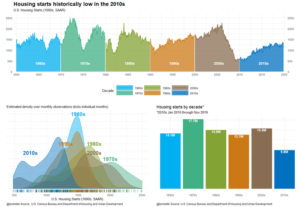A new report in Reason Magazine documents the way government impositions everywhere decreased the rate of housing construction in the U.S. during the past decade.
“The 2010s will end up with the lowest number of housing units started in 6 decades, by a wide margin.” This is causing (1) home prices and rents to increase–especially in the most regulated areas, (2) an explosion of homelessness–especially in the most regulated areas, and (3) a rapid expansion in commute times–especially in the most regulated areas.
California provides the most glaring example. In 1975 “the Golden State issued 131,732 housing permits” with a population of 21.5 million residents. In 2018, by contrast, Californian authorities permitted only 117,892 new units of housing for the state’s nearly 40 million residents. Californians must now commute much further and pay much more for housing. Homelessness and wealth inequality have exploded despite the California legislature spending more money on these problems than any other State.
“The question isn’t whether government regulation has constrained supply. Rather its which government regulations have restricted supply the most.” Zoning, environmental, prevailing wage, and historical preservation laws have all contributed.
Government regulations now account for about a third of the price of most housing.



